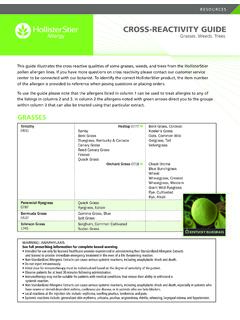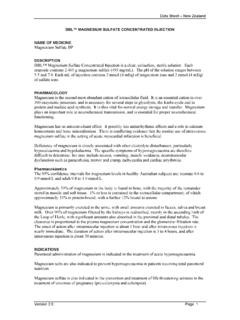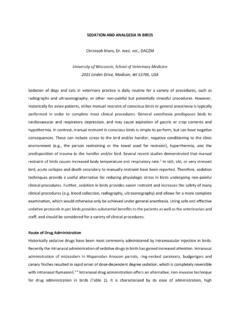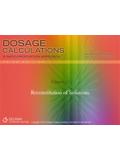Transcription of 150 mcg/mL of Can f 1 30x more concentrated than
1 ALLERGENIC E X TR AC T S. AP DOG. The highest concentration of dog hair extract available, proven in studies to be more effective for diagnosis and treatment. 1,2. ITEM NO. DESCRIPTION UNIT. 4825 AP Dog Hair and Dander Scratch 5 mL 1:100 w/v ITEM NO. 4825. AP Dog Hair and 10 mL, 50 mL. Dander Bulk Glycerinated 1:100 w/v 150 mcg/mL of Can f 1. 30x more concentrated than the conventional average of 5 mcg/mL of Can f 11. WARNING Important Safety Information (See full prescribing information for complete boxed warning.) Because Can f 1 can be present in every home (even homes without pets)3, you must have an effective dose for diagnosing and treating patients. Intended for use only by licensed Practice parameters recommend 15 mcg of Can f 14; you can easily dilute health care provider experienced in administering allergenic extracts AP Dog for this dose. To get an equivalent dose with conventional and trained to provide immediate products, you'd have to use approximately 3 mLs per shot.
2 Use AP Dog for emergency treatment in the event an accurate diagnosis, and for great patient care and of a life-threatening reaction. Observe patients for at least 30. minutes following administration. Proven Performance Immunotherapy may not be suitable for patients with medical conditions An effective diagnosis (and treatment) means you reach and benefit that reduce their ability to withstand more patients. Extracts with lower concentrations could result in false a systemic reaction. Allergenic extracts negatives during diagnosis. can cause serious systemic reactions, including anaphylactic shock and in Publications, studies, and abstracts have demonstrated the rare cases death, especially in patients performance of AP Dog for both diagnosis and treatment of dog- who have severe or steroid-dependent sensitive ,2. asthma, cardiovascular disease, or in patients who use beta blockers. Manufactured using our exclusive Acetone Precipitated (AP) extraction Do not inject intravenously.
3 This process for maximum concentration and efficacy. product is intended for subcutaneous injection for immunotherapy and Like all of our antigens, AP Dog is reconstituted with phenol-free percutaneous use for diagnosis. glycero-cocas; phenol can denature the proteins in allergenic extracts5. Refer to contraindications, warnings, precautions, adverse reaction and over dosage for more detailed information. *see reverse for footnotes QUALITY. PURITY. RELIABILITY. SEE INSERT INSIDE. 3525 North Regal Street | Spokane, WA 99207-5788. Footnotes 1 Turbeyville, M. Nelson, C. Mikita. Discordance Between Conventional and Acetone Precipitated (AP) Dog Extract in Skin Prick Testing. The Journal of Allergy and Clinical Immunology, Volume 121, Issue 2 (2008). 2 Anne M. Lent, MD, Ronald Harbeck, PhD, Matthew Strand, PhD, Michael Sills, BS, Kimberly Schmidt, RN, BSN, Benjamin Efaw, MS, Terri Lebo, BS, and Harold S. Nelson, MD.
4 Immunologic response to administration of standardized dog allergen extract at differing doses. The Journal of Allergy and Clinical Immunology, Volume 118, No. 6 (2006). 3 Arbes, Cohn, M. Yin, Mullenbert, W. Friedman, and Zeldin. Dog Allergen (Can f1) and Cat Allergen (Fel d1) in US Homes: Results from the National Survey of Lead Allergens in Housing. The Journal of Allergy and Clinical Immunology, 114(1), 111-117 (2004). 4 Cox ET AL. Allergen Immunotherapy: A practice parameter third update. The Journal of Allergy and Clinical Immunology, January 2011. 5 Nelson. Preparing and mixing allergen vaccines for subcutaneous immunotherapy. Lockey, Bukantz, & J. Bousquet (Eds.), Allergens and allergen immunotherapy, 4th ed., p. 315, 2008. 71000001950 H01 Rev 05/16. CLINICAL PHARMACOLOGY10 INSTRUCTIONS AND DOSAGE SCHEDULE The mechanism by which hyposensitization is achieved is not known completely. It has been shown that repeated injections of appropriate allergenic extracts will ameliorate the intensity of allergic symptoms upon contact with the allergen.
5 11, 12, 13, 14 Clinical studies which address the efficacy of immunotherapy are available. The allergens which have ALLERGENIC EXTRACTS been studied are cat, mite, and some pollen extracts. 10, 15, 16, 17, 18, 19. IgE antibodies bound to receptors on mast cell membranes are required for the allergic reaction, and their level is probably related to serum IgE concentrations. Immunotherapy IN BULK VIALS has been associated with decreased levels of IgE, and also with increases in allergen specific IgG blocking antibody. The histamine release response of circulating basophils to a specific allergen is reduced in some patients by immunotherapy, but the mechanism of this change is not clear. Further study and clarification of the relationships among changes in blocking antibody, reaginic antibody, and mediator-releasing cells, and between these three factors and Jubilant HollisterStier, LLC successful immunotherapy, is needed.
6 Spokane, WA 99207 INDICATIONS AND USAGE 20, 21, 22, 23 365107-H08 Allergenic extracts are indicated for use in diagnosis and immuno therapy of patients presenting symptoms of allergy (hay fever, rhinitis, etc.) to specific environmental allergens. Printed in The selection of allergenic extracts to be used should be based on a thorough and carefully taken history of hypersensitivity, and confirmed by skin testing. Rev. 05/11 Lic. No. 1272 The use of mixed or unrelated antigens for skin testing is not recommended since, in the case of a positive reaction, it does not indicate which component of the mix is respon- sible for the reaction, while, in the case of a negative reaction, it fails to indicate whether the individual antigens at full concentration would give a positive reaction. Utilization of such mixes for compounding a treatment may result, in the former case, in administering unnecessary antigens and, in the latter case, in the omission of a needed antigen.
7 WARNINGS Avoidance of allergens is to be advocated if possible, but cannot always be attained, , allergy to dog dander in kennel owners and employees, dog breeders, research This product is intended for use only by licensed medical personnel experienced in administering allergenic extracts and trained to provide immediate emergency workers, veterinarians, etc. treatment in the event of a life-threatening reaction. Allergenic extracts may potentially elicit a severe life-threatening systemic reaction, rarely resulting in death. 1 Allergens to which a patient is extremely sensitive should not be included in treatment mixes with allergens to which there is much less sensitivity, but should be administered Therefore, emergency measures and personnel trained in their use must be available immediately in the event of such a reaction. Patients should be instructed to separately. This allows individualized and better control of dosage increases, including adjustments in dosage becoming necessary after severe reactions which may occur recognize adverse reaction symptoms, be observed in the office for at least 30 minutes after skin testing or treatment, and be cautioned to contact the physician's with the highly reactive allergen.
8 Office if symptoms occur. See ADVERSE REACTION section of this package insert regarding adverse event reporting. Standardized glycerinated extracts may be more potent than regular extracts and therefore are not directly interchangeable with non-standardized extracts, or other manufacturers' products. Patients with CONTRAINDICATIONS cardiovascular diseases and/or pulmonary diseases such as symptomatic unstable, steroid-dependent asthma, and/or those who are receiving cardiovascular There are no known absolute contraindications to immunotherapy. See PRECAUTIONS and WARNINGS. drugs such as beta blockers, may be at higher risk for severe adverse reactions. These patients may also be more refractory to the normal allergy treatment regimen. Patients with cardiovascular diseases and/or pulmonary diseases such as symptomatic unstable, steroid-dependent asthma, and/or those who are receiving cardiovascular Patients should be treated only if the benefit of treatment outweighs the risks.
9 1 Patients on beta blockers may be more reactive to allergens given for testing or drugs such as beta blockers, may be at higher risk for severe adverse reactions. These patients may also be more refractory to the normal allergy treatment regimen. Patients treatment and may be unresponsive to the usual doses of epinephrine used to treat allergic reactions. 2 This product should never be injected intravenously. should be treated only if the benefit of treatment outweighs the risks. 1. Treat patients only with allergens to which they are allergic by skin test reaction, have a history of symptoms on exposure, and are likely to be exposed to again. Refer to the WARNINGS, PRECAUTIONS, ADVERSE REACTIONS and OVERDOSE Sections for further discussion. Any injections, including immunotherapy, should be avoided in patients with a bleeding tendency. Patients on beta blockers may be more reactive to allergens given for testing or treatment and may be unresponsive to the usual doses of epinephrine used to treat systemic reactions.
10 2. Since there are differences of opinion concerning the possibility of routine immunizations exacerbating autoimmune diseases, immunotherapy should be given cautiously to DESCRIPTION patients with other immunologic diseases and only if the risk from exposure is greater than the risk of exacerbating the underlying disorder. The allergenic extract in this vial is referred to as a bulk extract or stock concentrate since it is designed primarily for the physician equipped to prepare dilutions and mixtures WARNINGS as required. The extract is sterile and intended for subcutaneous injection for immunotherapy and scratch, prick or puncture for diagnosis. Unless specified otherwise, the See WARNINGS box at the beginning of this package insert. See also PRECAUTIONS. concentration of extract supplied will in most cases be expressed in weight to volume ( , 1:10 or 1:20 w/v) and will be the strongest available. Where mixtures of pollens and Allergenic extracts must be temporarily withheld from patients or the dose adjusted downward if any of the following conditions exist: (1) severe symptoms of rhinitis and/.







